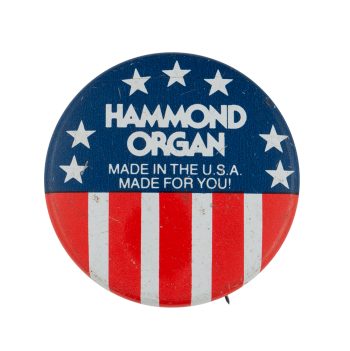| Category | |
|---|---|
| Additional Images | |
| Sub Categories | |
| Text on Button | HAMMOND ORGAN MADE IN THE U.S.A. MADE FOR YOU! |
| Image Description | White text on blue stars and red stripes background |
| Back Style | |
| The Shape | |
| The Size | |
| Additional Information | Invented by American engineer Laurens Hammond and first manufactured in 1935, the Hammond Organ initially offered a lower-cost alternative to both the piano and the wind-driven pipe organ. The instrument's unique sound and affordability quickly caught on with night club owners and jazz musicians and was eventually embraced by musicians throughout the 60s and 70s as a vital component in progressive rock bands such as Emerson, Lake and Palmer. While earlier advertisements remained targeted towards churches and "cozy family parlor rooms", the instrument's "unprecedented sonic versatility" inevitably found its true home with musicians in popular music genres. The original organ worked by generating a variety of unique sounds through the utilization of a rotating metal tone wheel. This produced an electric current which, in turn, was caught with an electromagnetic pickup. The resulting sound was strengthened by an amplifier and broadcast with a speaker -- most commonly a Leslie speaker, as it was thought that this brand worked best with the organ's sound. Initially, the musician would select the sound type by pulling the appropriate slide bar before playing. After a failed attempt to utilize integrated circuits in the instrument's make-up, the company sold its name to the Suzuki Musical Instrument Corporation in 1985, which now manufactures digitally-propelled varieties of the organ. |
| Sources |
Hammond Organ Company, est. 1928. (2019). Made in Chicago Museum. Retrieved from https://www.madeinchicagomuseum.com/single-post/hammond-organ-co The Hammond Story. (n.d.). Hammond. Retrieved December 2, 2024, from https://hammondorganco.com/the-hammond-story
|
| Catalog ID | AD0927 |




